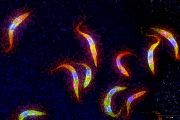
How does a cell make decisions? Searching answers thanks to the ERC grant
20. 06. 2022
Molecular biologist Alena Zíková from the Institute of Parasitology, Biology Center of the CAS has received a prestigious European grant – ERC Consolidator. At the beginning of June, the European Research Council (ERC) proposed her scientific project MitoSignal to be funded with 2 million euros for five years. Alena Zíková will study the mechanisms that enable communication within the cell, a fundamental cellular process. The new findings will have implications for many areas of biology, including human medicine as they may unravel the nature of various pathophysiological processes such as aging, neurodegenerative diseases or cancer. ERC grants are among the most prestigious in Europe; in recent years, three other scientists from the Biology Center of the CAS have received such grants.
Inside each cell there is lively communication between the different organelles. The nucleus listens carefully to this information and decides what to do next. There are many possibilities: the cell can divide or differentiate into another cell type, it can "fall asleep" and wait for better environmental conditions, or it can commit suicide. Mitochondria are among the most important organelles that influence cell fate. These cell factories not only supply the cell with energy and a number of important metabolites but they also communicate their biosynthetic and bioenergetic fitness. The cell then decides whether these powerful organelles can provide enough replenishment to make certain cellular decisions.
Oxygen radicals - when are they vital and when are they harmful?
Information is transmitted by a variety of signals. Surprisingly, reactive oxygen species (ROS), also known as oxygen radicals, are among these signals, as was recently discovered. These molecules have been extensively studied because when produced in excess, they cause severe cell damage that can lead to cell death. The overproduction of ROS molecules is often associated with various pathophysiological conditions, such as aging, neurodegenerative diseases, and cancer. However, the vital role of ROS in cellular communication is still poorly understood. Therefore, the proposed research aims to unravel the fundamental molecular mechanisms underlying the intricacy of ROS signaling.
Parasite as a model organism
Alena Zíková came to this research rather by accident when she was studying the single-celled parasite Trypanosoma brucei, which causes sleeping sickness. "We studied how the parasite changes from one developmental stage to another in the tse tse fly, and since we focused on mitochondria, we found that this change was associated with a higher production of oxygen radicals. This was a very interesting finding for us. Normally, these molecules harm the cell, but in this case, they helped it develop into a new cell type," says the biologist, who will study how oxygen radicals drive this natural cellular differentiation. She proposes using trypanosomes as an elegant and simplified model organism that has many advantages over complex multicellular model systems: T. brucei is a unicellular organism that has only one large mitochondrion (compared to, for example, mammalian cells, which contain dozens of these organelles), and this organelle changes significantly during parasite development.
Alena Zíková's team will use state-of-the-art methods and tools, such as mass spectrometry or the methodology of the so-called gene scissors (CRISPR / Cas9). Genetically modified parasites in combination with various substances will make it possible to manipulate the levels of oxygen radicals in mitochondria and determine their effect on parasite differentiation. Mass spectrometry will be used to determine how the ROS signals are distributed in the cell.
New findings will also help in medicine.
Thanks to ERC funding, Alena Zíková's team has a unique opportunity to use its rich experience with the model organism Trypanosoma brucei to elucidate a fundamental molecular process in the cell. "Since this is such an important and evolutionarily old process, we are convinced that our findings will have a great overlap with other organisms, including humans. Our research will make it possible to determine the boundary between the time when oxygen radicals are vital for the proper functioning of the cell and the time when, on the contrary, they are already harmful," Alena Zíková explains. In the future, this information will help to decipher the nature of diseases caused by stress and overproduction of reactive oxygen species, and it will also be important for studying the effect of various antioxidants and their use in the treatment of numerous human diseases.
Read also
- Scholars from the Czech Academy of Sciences will help make key UN documents on refugee policy in post-communist Europe accessible
- New perspective on the climate crisis: an ERC Consolidator grant
- World first for Czech science: egg ageing can be reversed
- How the human genome duplicates. A Czech becomes a new EMBO Young Investigator
- For the First Time Ever, a Czech Scientist Wins the international Dream Chemistry Award
- AI recognises parasitic eggs better than the average ornithologist
- IOCB researchers take a key step toward fully controllable molecular machines
- Two of Europe´s most prestigious grants awarded to the Czech Academy od Sciences
- Czech scientists discover a cellular “safety switch” that protects DNA from damage
- Fungi may use toxic substances to spread skin infections from guinea pigs to children
Contacts for Media
Markéta Růžičková
Public Relations Manager
+420 777 970 812
Eliška Zvolánková
+420 739 535 007
Martina Spěváčková
+420 733 697 112


